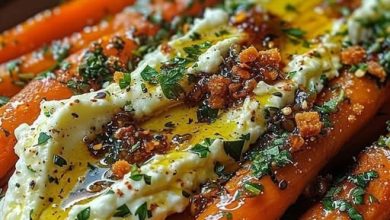Yorkshire pudding Light, Puffy, and Perfect for Roasts

This classic Yorkshire pudding recipe yields high, golden brown puddings with a crisp crust and tender, airy interior. Ideal for soaking up rich gravies, these unctuous savories go well with roast beef, lamb or pork. With a handful of simple ingredients and a searing oven, you’ll have the ultimate accompaniment for a classic Sunday roast. Serve straight away for optimum results, and note them disappear!
Reasons You’ll Love This Yorkshire Pudding Recipe:
Ideal for Roasts: Yorkshire puddings go wonderfully with roast beef, lamb or pork, and is a perfect companion for a rich gravy.
Light and puffy: Unless you’re using a different method (shudder), you’ll get tall, airy puddings that are crisp on the outside and soft on the inside.
Few Ingredients: Four humble ingredients — flour, milk, eggs and salt — come together to create a showstopper with minimal prep.
Fun to Make: Always thrilling to watch the batter puff up in the oven, and you’ll improve with each iteration.
Family Favorite: Yorkshire pudding can be served traditionally or with creative toppings, and kids — as well as grown-ups — love its versatility.

Key Ingredients:
Here’s what you need to know when choosing and handling ingredients to set up this Yorkshire pudding recipe to be a success!
All-Purpose Flour
The Base of Fluffiness: All-purpose flour provides the structure that allows the puddings to rise.Sifting Tips: Always sift the flour before you add it to the mixture so it doesn’t clump; this will guarantee a smooth batter.
Substitutes: For a chewier bite, you can also use bread flour, but do not substitute cake flour — that will not provide gluten structure.
Milk
Dairy Delight: Using whole milk bestows a richness to the batter, helping Yorkshire puddings to brown and rise.
Room Temperature Tip: If using milk, bring it to room temperature before mixing; this helps prevent lumps and also helps the batter cook evenly.
Alternatives: If you want a dairy-free option, almond or oat milk can be used, but be aware that they will alter the final texture a little.
Eggs
Egg Power: Eggs are a must for the pudding’s structure, lift and golden color.Whisking Tip: Beat the eggs well so they introduce some air into the batter, which helps it rise.
Room Temperature Is Important: Cold eggs will firm up the batter and prevent a proper rise, so let them sit out for a while before mixing.
Salt
Flavor Booster: Not only does salt season but it also helps to even out the batter’s richness and uplifts the final flavor.
Sea Salt vs. Table Salt: For best blending, use fine sea salt or the table salt as the coarse may not completely dissolve.
Oils or fat from meats (like drippings from pot roast)
For that Classic Crisp: Beef drippings are traditional and impart a beautifully umami flavor, but vegetable oil is also fine for a lighter outcome.
Goldilocks: About ¼ inch in each muffin tin cup. Too little, and the puddings can stick; too much, and they’ll be greasy.
Heating It Up: It’s a must to heat the oil until it’s smoking hot. This process is the one that ensures a crispy, golden crust.
Step-by-Step Instructions
Preheat Your Oven:
Heat the oven to 425°F (220°C). Yorkshire puddings require a hot oven to rise properly, so make sure it is up to temperature before you begin.
Prepare the Muffin Tin:
Put a 12-cup muffin tin in the oven as it preheats. A heated tin is paramount for Yorkshire pudding; the goal here is the same: a perfect rise and yeah, crisp.
Make the Batter:
In a big mixing bowl, beat together:
1 cup all-purpose flour
1 cup milk
4 large eggs
½ teaspoon salt
Whisk until smooth and free of lumps; the batter should be thin, similar to pancake batter. For best texture, keep whisking until the lumps are completely incorporated.
Heat the Oil:
Using caution, remove the hot muffin tin from the oven.
Top each muffin cup with about ¼ inch of vegetable oil or beef drippings. Put the tin back in the oven for another 5 minutes, until the oil is popping hot. Hot oil is a key to crispy, well-risen Yorkshire pudding.
Pour the Batter:
Now that the oil is hot, take the muffin tin out of the oven again.
Ladle the batter into the hot oil, filling each muffin cup half … Be careful not to overfill, as the puddings will puff up greatly in the oven.
Bake to Perfection:
Place the muffin tin back in the oven and bake for 20–25 minutes. The puddings are ready when they’re puffed up and deep golden brown.
Do not open the oven door as they are baking; this can make them fall. The secret to fluffy Yorkshire puddings is consistent high heat along with a properly prepared tin.
Serve Immediately:
Yorkshire puddings are best served fresh from the oven. Serve them as part of a traditional roast dinner and eat them with beef, lamb or pork, pouring rich gravy over the top for a classic meal.
Serving Suggestions:
Yorkshires are versatile! Here are ways to bring them up to the table:
Classic Roast Pairing: Roast beef + roasted lamb or pork with roasted vegetables + a full-bodied gravy. Time-tested, delicious and popular with hungry people.
Breakfast Twist: Stuff ’em with scrambled eggs, crispy bacon and a drizzle of maple syrup for a savory brinner.
Mini Yorkshire Pudding Pizzas: Spoon on a dollop of marinara sauce, sprinkle on cheese, bake until melted — ideal for a kids (or adults’) snack.
Sausage and Onion Filling: Slice the puddings in half and stuff them with sausage and caramelized onions for a hot and salty nibble.
Storage and Meal Prep Tips:
Yorkshire puddings are best made to order, but you can prep them in advance or store any leftovers with these tips:
To keep in refrigerator: “Scoop up” any leftover food and put it in air-tight container and put in refrigerator for up to two days. Or, reheat them in the oven at 350°F (175°C) for 5-8 minutes to crisp them back up.
Freezing: Freeze the puddings flat on a baking sheet, then transfer to a freezer-safe bag or container. From frozen reheat at 375°F (190°C) for 10-15 minutes.
Make-Ahead Batter: The batter can be prepared up to a few hours in advance and refrigerated. A quick whisk before pouring it into the hot oil is all that is required.
Also, for extra inspiration, if you’re pairing these Yorkshire puddings with classic roast beef, our roast beef recipe is a good place to start. Or make these with our easy vegetable gravy recipe for a vegetarian twist!
Variations to Try:
Put your mark on Yorkshire puddings with these delicious twilists.
Herb-Infused Puddings: For a fragrant twist, add 1 to 2 teaspoons of chopped fresh rosemary, thyme or parsley to the batter.
Cheesy Yorkshire Puddings: After you add the batter, toss a little shredded cheddar or parmesan into each muffin cup before putting them in the oven for a cheesy, savory upgrade.
Garlic and Herb: Mix ½ tsp garlic powder and some fresh herbs into the batter for a delicious variation.
Whole Wheat: For a heartier loaf, substitute half the all-purpose flour for whole wheat flour. It lends a nutty flavor and additional fiber, without sacrificing too much of the fluff.”
Conclusion:
Yorkshire pudding really is a classic for a reason—it’s delicious, versatile and always a crowd-pleaser. Follow these tips and tricks, and you will get a perfectly light, crispy Yorkshire pudding that will impress. Once you have the technique down, experiment with flavors and serving methods. Whether you’re keeping it traditional or fancy, this recipe is a sure-fire hit. Enjoy!



